I have done two previous surveys of Rosebank, a small town on the southeast edge of Staten Island bordered by the SIRT cut, the Verrazano Bridge approach, and the Staten Island Expressway. I have always enjoyed its collection of tiny streets that go nowhere, punctuated by lengthier roads like Hylan Boulevard and Bay Street that run the lengths of the island’s eastern and southern shores. I even lived in Rosebank for a week in 2005, when I stayed at a B&B across from the Alice Austen House while researching Staten Island scenes for the ForgottenBook. On this occasion, I walked Tompkins Avenue, which I had largely bypassed before, and snapped scenes on Tompkins and its tributaries.
Formerly Peterstown, in the 1880s the region came to be called Rosebank presumably for an abundance of rose bushes and its location on the shore. It has always been known for its Italian population, as immigrants began arriving here as early as the 1880s. The present population numbers about 16,000. A substantial part of the shorefront east of Bay Street was taken up by a maritime quarantine station from 1873-1971; the site is now occupied by Coast Guard housing. Rosebank is nationally famed for the presence of the Our Lady of Mount Carmel Grotto on Amity Place.
Getting to Staten Island from Little Neck is a 2-hour or better affair without a car, but I’m glad I don’t have to pay a double-digit bridge toll as some motorists have to do every day. I got the Long Island Rail Road to Penn Station, changed for the A train and used the new connection at Jay Street/Metrotech for the R train. I took that to 86th Street (my home subway station when I lived in Bay Ridge) and then, changed for the S53 bus over the Verrazano Bridge.
ForgottenFans and friends know I complain a lot. Today I come to praise the MTA, not to bury it. I am able to get from Penn Station to far reaches in Staten Island for $2.25, and in the past few months, the MTA has opened very convenient transfers at Jay Street in downtown Brooklyn and also at Court Square on the #7 Flushing Line, where I can now make an easy transfer to the Brooklyn Crosstown (G) and Queens Boulevard/6th/8th Avenue Lines (E, M). The MTA is still awash in boondoggles like the big glass thing being built at Fulton and Broadway, or the 2nd Avenue Subway, which will open when I’m on Medicaid, but they do get some things right.
I got off the S53 on Lily Pond and Major Avenues in picturesque Arrochar and walked west past the busy Staten Island expressway interchange up Lyman Avenue.
I passed a Little League field with the Verrazano Bridge behind the outfield fence, and a one block street that’s quite a mouthful, Dennis Torricelli Senior Street. Older maps show this as a southern extension of Summer Street. This street is typical of the former NYC method of renaming streets for historic personages and local heroes (I presume Mr. Torricelli is among the latter). Formerly, the Department of Transportation went whole hog and simply replaced the name, as in Frederick Douglass Bouelevard in Harlem (formerly 8th Avenue) or Mother Gaston Boulevard (formerly Stone Avenue in East New York). Sometimes, the public refused to acknowledged the new name (6th Avenue/Avenue of the Americas).
Of late, the original name is retained, but the new name is on a different sign installed under the old sign, as in all the policemen, firefighters and others murdered by terrorists on 9/11/01.
The intersection of Summer and High Streets typifies the tiny, one or two block streets that dominate Rosebank. High Street was likely named for the slight rise it has running east.
Summer Street fire alarm and fire hydrant. Fire control in NYC has given rise to two iconic fixtures that have dominated NYC streets since the 1910s– consult photographs from the era, and you will see alarms and hydrants that look exactly like these.
In the era of mobile phones and 911, the FDNY has announced a plan that would eliminate all street fire alarm call boxes. The plan would save an initial $6 million. Most alarms placed from these boxes are false. Some communities, however, oppose the measure, as we see here.
This hydrant’s paint job likely dates back to the 1976 Bucentennial, when hydrants all over town were painted red, white and blue.
I couldn’t resist Bang Terrace, a dead end issuing north from Fingerboard Road west of Bay Street. Walking to its end I noticed a few new houses at its rear end. The origin of the name is anyone’s guess but it could have been a prior property owner.
RIGHT: Fingerboard Road, which runs from Bay street west to Hylan Boulevard, and West Fingerboard Road, from Hylan Boulevard to Richmond Road, show up on Staten Island maps by 1880. The roads were not named for any string instrument players in the area; according to legend, a large, finger-shaped wooden sign pointing the way to the Richmond County Courthouse, then located at the end of Richmond Road in Richmondtown, was installed someplace on the road.
I traveled north up Home Avenue, which has several well-kept, well-built homes, to its end at Hope Avenue — home is where the hope is, unless it’s not.
88 Hope Avenue is a handsome 1890s-era house on a wide plot. Across the street are several new homes that were built on the right of way of the old Staten Island railway South Beach Branch.
The SIR South Beach Branch was a later extension of the main branch from St. George to Tottenville and traveled through Rosebank and Arrochar to Wentworth Avenue in South Beach. Though grade crossings were eliminated in 1935, service ended just 18 tears later, in 1953. Though by 2011 most traces of the railroad had been built over, there are still a few (see below). As you can see from this 1949 Hagstrom map, the Belair Road station was located here along Cabot Place between Belair Road and Hope Avenue. Trains traveled on overpasses or in open cuts under streets.
From musician Gary Owen’s comprehensive Staten Island railway website, here are two photos of the Belair Road station in 1934 at grade and then in 1936, after the grade was eliminated.
One remnant is the angle that Cabot Place takes between Hope and Belair.
Once again on Tompkins Avenue, I explored two dead end alleys. Meyer Lane has no property facing it and is now apparently just a way to get to some parking sheds. There’s an abandoned estate to the north of the lane.
1874 property maps show acreage here belonging to a Louis H. Meyer. The website of the Mount Manresa Retreat House (on Fingerboard Road west of Tompkins) provides some information about him:
About 1860 a Mr. Browne sold the property on which Mount Manresa stands to Louis H. Meyer, one of the first presidents of the Staten Island Savings Bank. Mr. Meyer joined the exclusive group of the wealthy who established Staten Island estates, earning them the name of the “Staten Island Barons.” The then 20-acre parcel contained a square brick house with a mansard roof that he named Fox Hill Villa. The large double house contained more than 20 bedrooms and had a dining room that could seat 60. Mr. Meyer created vistas on the property to see New York Harbor. He sub–drained and surface drained the property. Mr. Meyer imported various trees and shrubs from Europe. As there was no water supply, he sank an artesian well, built a water tower, and constructed large cisterns. He also constructed greenhouses for tropical fruit. Louis Meyer had a grotto built on the North face of the hill. He produced Shakespearean plays in this grotto. After the death of Louis, and his wife Anna, Fox Hill Villa fell into disrepair and became a boarding house...
Just north of Meyer Lane and the abandoned estate sits Wadsworth Terrace, a step street leading to a couple of well-obscured private homes. The terrace is named for the nearby US Fort Wadsworth, which in turn was named for Civil War-era general James Samuel Wadsworth (1807-1864).
During the Civil War, though without military training, he served with distinction as a brigadier general and saw action at the First Battle of Bull Run, the Battles of Fredericksburg and Gettysburg, and was killed during the Battle of the Wilderness in 1864. Sanna Feirstein, Naming New York, NYU Press, 2001
Tompkins Avenue, Rosebank’s primary north-south artery along with Bay Street, runs from Canal Street in Stapleton southeast to the interchange with the Staten Island Expressway. It was named for Staten Island resident, NYS Governor (1807-1817) and later USA Vice-President (1817-1825) Daniel D. Tompkins, whose name appears in many locales throughout the city, in Manhattan’s Tompkins Square and Brooklyn’s Tompkins Avenue. Tompkins founded the town of Tompkinsville in Staten Island in 1815 and initiated ferry service to New York in 1817.
The dates of installation of NYC fire hydrants lurk under the sidewalk surface. On this exposed pipe 10/28/1937 shows up.
711 Tompkins, between Hope and Belair, is a fine example of 20th Century construction with a double porch and dormers. The object across the street is what we have in the 21st Century.
Woodland Cottage
My own photo of Woodland Cottage, 33-37 Belair Road, didn’t come out very well — there was abig SUV parked in front — so here I borrow a photo from NYC chronicler Emilio Guerra, who provides a thorough synopsis of the house and its history at the link.
Detailing from the cottage. The original cross-gabled section has steep roof slopes outlined by bargeboards. Holden’s Staten Island, Richard Dickenson, CMS 2002
From the ForgottenBook: On Belair Road between Bay and Wingham Streets you’ll find the remnants of suburban development that begun here in the 1830s, most notably Woodland Cottage at 33-37 Belair Road. The Gothic Revival cottage was built in 1845 and served as the rectory of St. John’s Episcopal Church between 1858 and 1869. Of special note are the second-floor casement windows with diamond-shaped panes.
Next door is 25 Belair Road, likely from the same era with similar roof slope treatments.
St. John’s Episcopal Church
At Belair Road and 1331 Bay Street stands historic St. John’s Episcopal Church, constructed from 1869-1871 with architect Arthur D. Gilman. The parish was established in 1843, and its historic plaque claims that ferry/railroad magnate Cornelius Vanderbilt (born nearby in Stapleton in 1794) was the first child baptized in the original frame building across the street, but those dates don’t seem to jibe.
The rectory (right) opened in 1882 and was also designed by Gilman.
Some classic Belair Road and Bay Street architecture, and a new gleaming CEMUSA bus stop, alongside the bench that had formerly gotten the job done.
At Bay Street and St. John’s Avenue we find a building originally owned, or built by, an M.J. Rottmann in 1885. Names and dates of construction were frequent features in that era.
Ancient fire alarms and sewer grates, Bay Street and Scarboro Avenue. Whenever you see a peak-roofed NYC fire alarm box, it’s one of the originals, having been installed from 1912-1913. The lengthy shaft at the top originally held a lamp alerting carriage drivers and motorists to its presence at night. The working box at this corner is actually mounted to a telephone pole.
A old school functional sewer grate — actually a hole in the concrete — is across the street.
A sampler of Bay Street storefronts between St. Johns and Maryland Avenues — De Luca General Store, with its NYC classic plastic-letter facade; brick building covered with flag mural, likely inspired by 9/11/01; Phrygian Studios, one of a number of recording studios in the area; and the cursive and Art Deco hand lettered Expressions By June hair salon sign.
Phrygia, in ancient times, was a kingdom in central Turkey. By the 500s AD it had been conquered by the Trojans, the Persians and finally, the Romans. Its culture was largely absorbed into Greek culture after the Greeks overwhelmed Troy. The Phrygian cap, a style favored by the Phrygians, has turned up as a symbol of liberty in many iconographies, including US coinage.
Zinnias and marigolds along the sidewalk on St. John’s Avenue west of Bay street.
Railroad remnant
One of the most identifiable remnant of the old Staten Island Railway can be found at St. John’s Avenue and Clayton Street — a stone wall stamped with the date 1936. The railroad once passed here north of the Belair Road station. Service ended in 1953, and gradually, all trace of the railroad in the neighborhood has otherwise vanished.
Two photos of the same site in 1936, when the stone walls and trestle were new.
And on the pedestal these words appear:
`My name is Ozymandias, King of Kings:
Look on my works, ye mighty, and despair!’
Nothing beside remains. Round the decay
Of that colossal wreck, boundless and bare,
The lone and level sands stretch far away”.
Percy Bysshe Shelley
Though they show up on maps as early as the 1940s, it wasn’t till the last couple of decades that a group of streets off St. Johns Avenue west of Tompkins named for classical composers (Beethoven, Wagner, Schubert, Rubenstein, Strauss, and Mendelsohn) were developed.
Other clusters of streets in Staten Island are named for European rivers (Grasmere); Prohibition Party Presidential candidates (Westerleigh); and astronauts ( Heartland Village).
Looking down St. John’s Avenue toward the bay. Bay Ridge, Brooklyn is on the horizon and the spire of St. John’s Church is on the extreme right.
Tidy Rosebank homes on James Place and Thompson Place; attached homes on Tompkins between Maryland Ave. and Hylan Boulevard
From the intersection of Tompkins Avenue and Hylan Boulevard, the Manhattan skyline looks tantalizingly close.
Rosebank has a few streets bearing states’ names: Maryland, Virginia, Vermont. It used to have two more: New York Avenue, which was renamed Bay Street in the early 20th Century, and Pennsylvania Avenue, which became Hylan Boulevard when the boulevard was constructed from Rosebank to Tottenville along Staten Island’s south shore in the mid-1920s.
Tompkins Avenue takes a NW jog at Hylan Boulevard and a traffic triangle here commemorates local hero Anthony Zavarelli, a Vietnam veteran who perished at the Twin Towers on 9/11/01.
“The Rosebank Boys Association is an organization composed of long-time residents of the Rosebank section of Staten Island. The organization carries out fund raising activities throughout the year to benefit various local charities. ” Building Homes for Heroes
A new Walgreens stands at Tompkins and Hylan. Why feature such an everyday object — after all there are hundreds of Walgreens in the NYC area alone! Apparently, in Rosebank, there was a movement to keep out the big drugstore chain, that was apparently unsuccessful. Rosebank Pharmacy, at Clifton Avenue a block away, seems to be doing all right.
The Tompkins Tavern, now Le Fandy on Tompkins near Virginia Avenue, has some ancient painted advertisements on the side wall facing the parking lot.
The Rosebank Honor Roll, on Tompkins Avenue across from St. Joseph’s Church on Shaughnessy Lane, celebrates Rosebank residents who served in that conflict.
The Garibaldi-Meucci Museum, Tompkins Avenue and Chestnut Avenue. Giuseppi Garibaldi was the military crusader who fought for a united Italy, and Antonio Meucci invented the telephone, but was unable to afford a patent; Alexander Graham Bell, who was working on a telephone at the same approximate time, obtained his patent, and the rest is history.
Please see my writeup on my previous Rosebank page for more information on these two Staten Islanders, however temporary.
Meantime, I’m fascinated by the Meucci monuent on the lawn because of its friezes depicting classical-era gambols and frolics. The inscription in Italian on the monument describing Meucci’s career is well-worn and could use a restoration. Across the street is the Auto Tech car repair shop. I love it when monuments to great men are situated in humdrum, everyday locales.
Huge warehouse on Tompkins on the north side of the active SIRT tracks. I wonder what its original purpose was.
Townsend Avenue was originally the driveway leading to the estate of brothers James, Charles and William Townsend, who built a Gothic Revival castle in the center of the plot in the 1840s. In the 1850s, land along the driveway was subdivided into plots and in the latter half of the century a collection of other Gothic Revival and Queen Anne style homes was built up and down the street. Unfortunately in the past decade, many of these have disappeared as developers have erected generic multi-family homes they have deemed more suitable for the region in the early 2000s. A few do remain, though, such as the one on the north side of the avenue near Tompkins.
Unfortunately the area was never landmarked and perhaps, this corner building on Tompkins Avenue may be on the way out, too.
Adventures in Vandy-land
I’ll halt the proceedings before pressing too far into Clifton and Stepleton, but I’ll note some of the area’s more engaging architecture at Vanderbilt Avenue just east of Tompkins:
Cornelis Vanderbilt, born in Stapleton in 1794, began his career operating Staten Island’s first ferry to Manhattan beginning in 1810. The Vanderbilt family has always been associated with Staten Island; several family members are buried in a lavish mausoleum in Moravian Cemetery in Todt Hill.
In 1900, the firm of Carrere and Hastings built eight houses along the family’s namesake avenue, from 110 to 144, between Talbot Place and Tompkins Avenue for George Vanderbilt in 1900. Other houses were built for Vanderbilt on neighboring Norwood Avenue; additional mansions were found on nearby Townsend Avenue, but many of them have been lost to redevelopment.
9/11/11

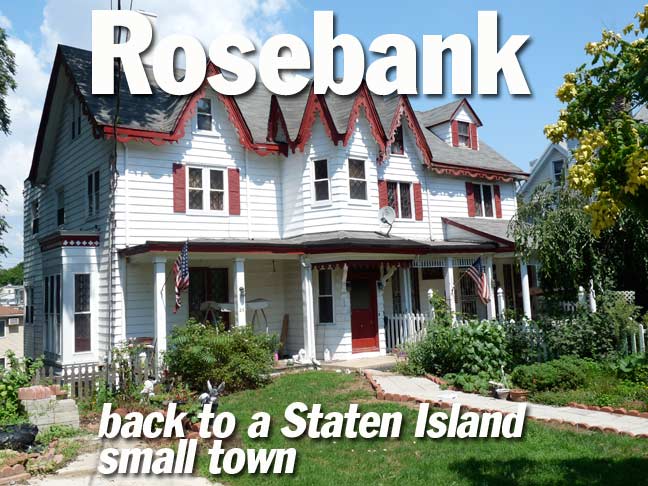
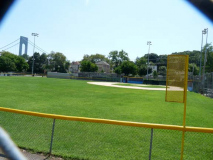
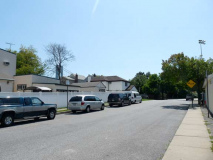
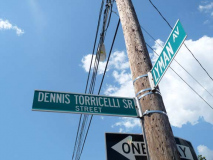
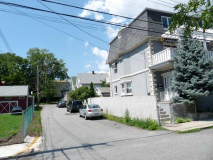
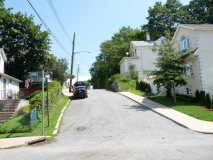
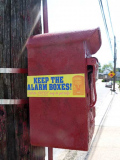
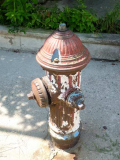
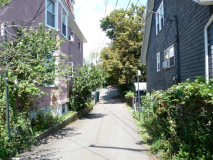
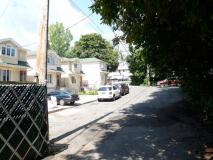
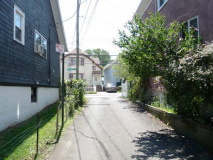
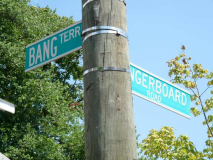
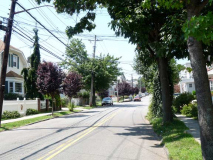
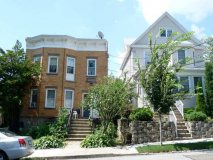
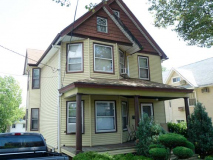
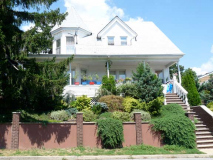
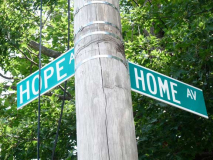

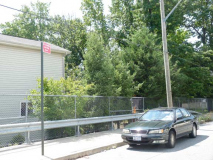

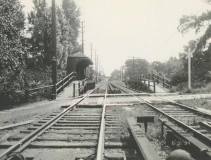
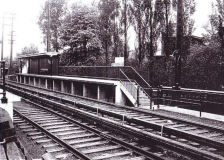
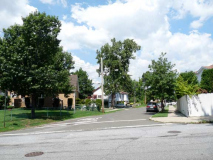
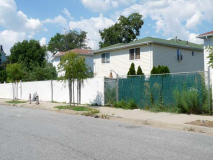
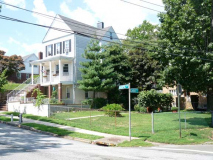
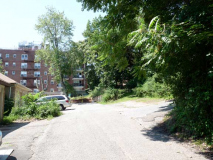
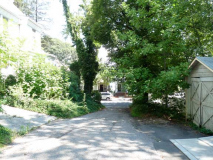
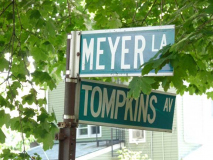


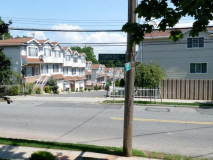
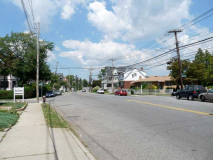
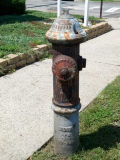
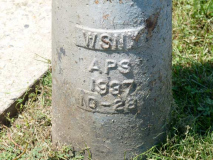
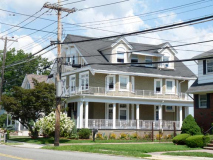
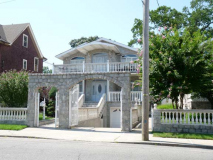
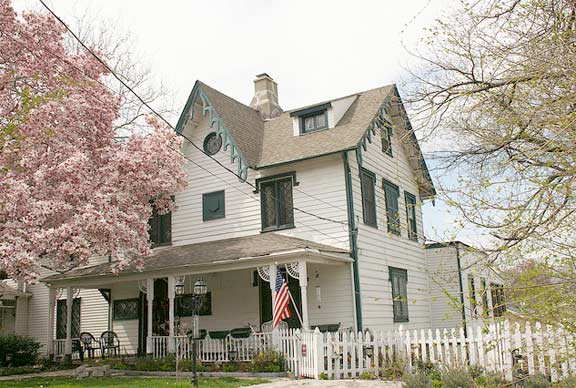
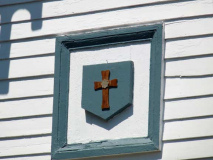
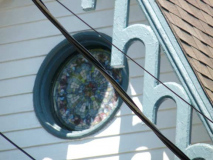
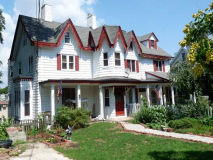

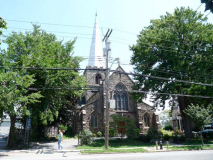
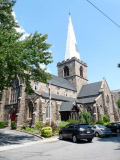
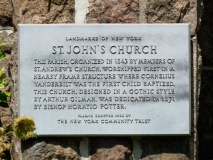
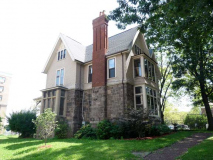
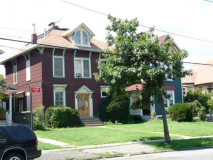
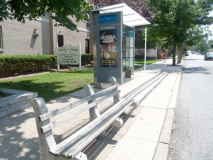
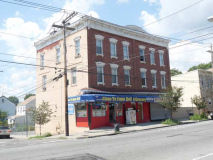
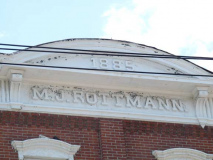
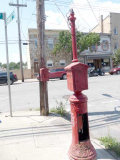
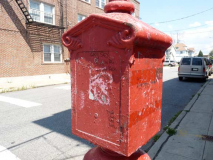

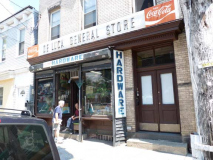
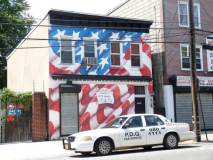
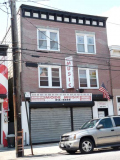
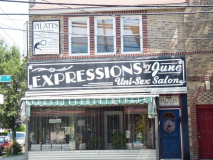
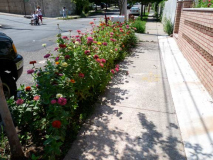

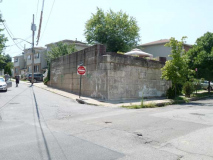
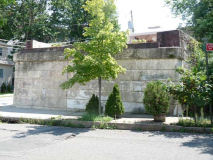
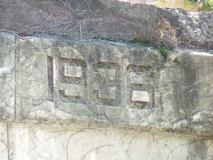
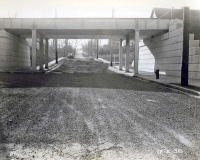
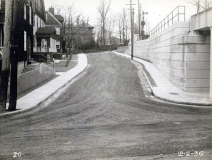
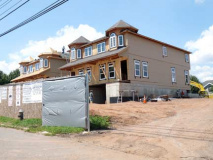
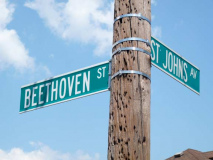
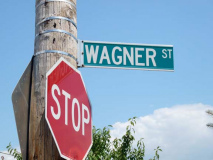
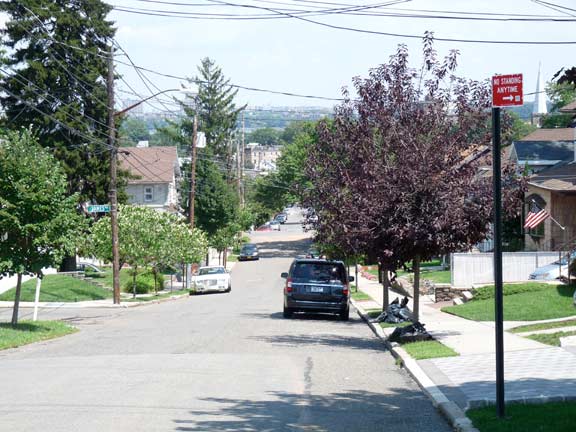
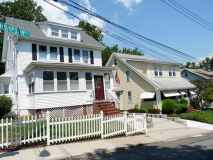
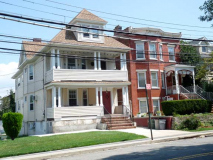

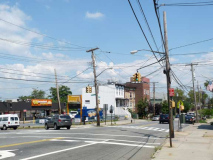
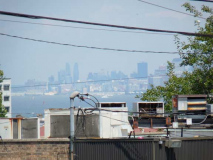
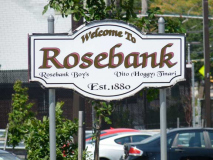

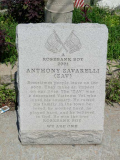
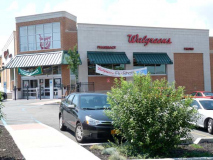
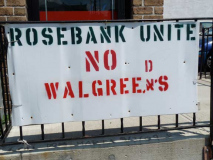

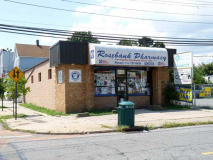
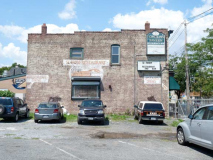

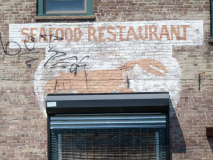
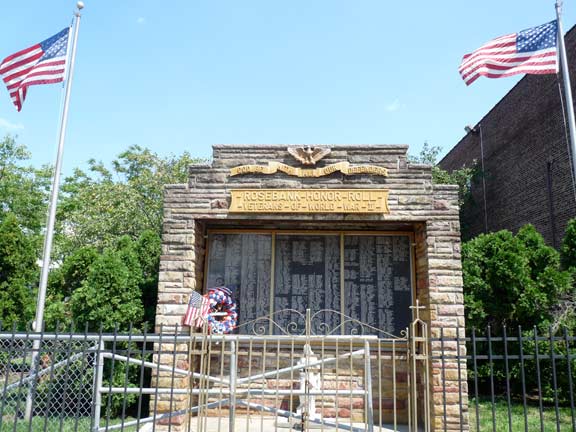
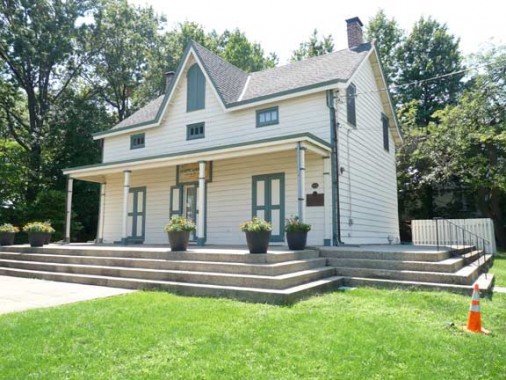
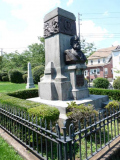
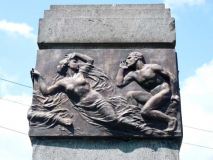
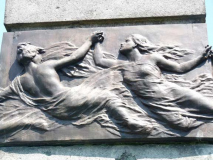
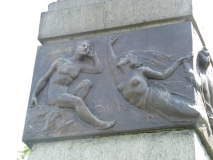
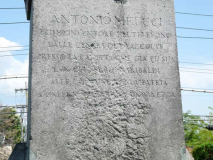
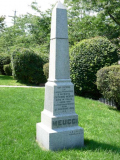
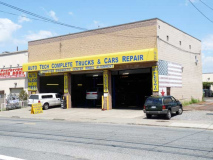
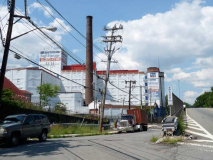
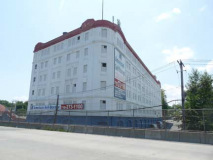
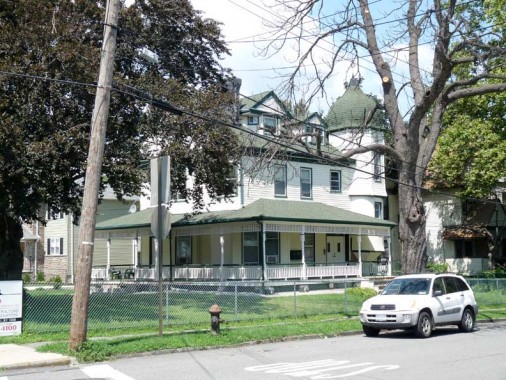
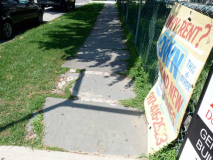


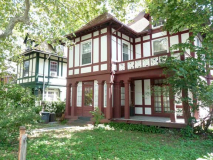
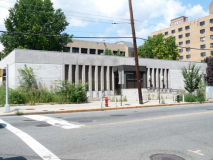
44 comments
What a lovely looking neighborhood, some excellent structures in there. Wonderful writeup as always!
Please always keep in mind that from St.Johns avenue to Wadsworth avenue is considered Ft. Wadsworth and not Rosebank !
Really? I lived on the southwest corner of St Johns and Bay….1286 Bay Street and always thought it was Rosebank. Do you have a reference for that? Section or town map?
Agree. My in laws have lived between St John’s Ave. and Wadsworth Ave. for 50 years and they consider their neighborhood to be Ft. Wadsworth.
Well done Kevin. My parents live in Rosebank, and the neighborhood kinda grows on me whenever I visit. I’ll be sure to take a more comprehensive walk around the town next time I visit them.
Hi Kevin, I knew you had to upgrade the website, but one little thing is really annoying. The tiny pictures! Yeah I know they zoom, but it pushes the page to the top no matter where the photo is located. A viewer does need to see all the pictures so it doesn’t make any sense to have them small. Please put the larger size back.
Will try and do more full size photos. The problem about scrolling is specific to firefox and we are working on it. Meantime, it works fine in safari, explorer and google chrome.
This is my favorite site for years, but the little pictures are killing me………
OK, OK. Newer pages will have full size pictures.
You spoiled us for too many years Kevin. We love the larger pics – especially those of us whose eyes aren’t what they used to be.
Larger photos will be on this week’s feature page late Sunday and in subsequent ones, and as many pages as possible that I am bringing over to wordpress from the old site.
Nice piece! Rosebank is one of my favorite Staten Island neighborhoods to explore, too. I did a couple pieces on abandoned industrial buildings there back in 2008 – an old pigment factory and a gum factory:
http://kensinger.blogspot.com/search?q=rosebank
Sadly, the pigment plant is gone now (it was across from the Garibaldi house). The NY Times had a great article on its history, though, and about the pink pigeons that used to fly around Rosebank:
http://www.nytimes.com/2008/02/10/nyregion/thecity/10color.html
Oh, and i agree – bigger photos!
Nathan
I know that gum factory building. Just down the road from the B& B I stayed in a few years ago.
Yes, I stayed in a B&B in Staten Island.
Wonderful text & photos. Neighborhoods such as Rosebank are becoming rare treasures. The more we photograph & give the history of these areas, the richer our lives and that of those who follow become.
In all likelihood, the Cornelius Vanderbilt who was baptized in St. John’s Church was Cornelius Vanderbilt II – (November 27, 1843 – September 12, 1899).
Lovely text, as usual. But using “Safari” to bounce “back” from an enlarged thumbnail to the text, as suggested, doesn’t work for expatriates out here in Indiana. Sometimes I’m returned to the top of the page; sometimes I’m zapped to another display — the Checker Cab picture, usually! Maybe it’s a problem with Mac OS X.15. A geezer my age can’t afford to spend too much time scrolling back and forth…. 🙂
You’re sure you’re on Safari? That has been a firefox problem.
In any case so many have complained abt the thumbnails (I don’t mind flipping back and forth) I am making new pages with full size pictures. I waved the white flag.
Yes, I used both Safari and Firefox separately, to make sure. But out here, west of the Appalachians, all kinds of strange things go on. Waiting for the IRT # 4 can be downright excruciating….
Thanks much. Think of the concession as a reasonable New-Yorkish adaptation, not a surrender. It’s greatly appreciated. 🙂
Great page! Kevin, I have a question about a few Staten Island neighborhoods you did awhile back. I’ve been looking for the Hamilton Park, Clifton and I think Stapleton Heights pages but couldn’t find them. Were those pages deleted or are you in the process of adding them here from the old site?
Yes, I am in the middle of moving pages over to WordPress, since there are over 1100 and I have to reconfigure many of them, it will take till November, at least, but everything will be restored eventually.
Your site is very nice. My parents are from rosebank and fort wadsworth.
I have a question . What can you tell me about the mansion that sat btw bay street and the former train tracks? The house had an easment driveway down the back to hope ave. The grandfathe A mr Mcguiness built it owned it.? What caused the demize of that beautiful mansion?
I’ve been searching for the same information too. If it’s the same house I’m thinking of, all the neighborhood kids would play in it after it was abandoned. I remember a huge sweeping staircase, red velvet wall paper, and a widows walk up on the roof. We lived at the top of Evelyn Place and the driveway for that house ran off of Hope and then circled down to Belair. The house sat up on top of a hill.
We left there in 1974 and my sister has gone back to drive around. She says the house is gone. I know when we were there as children, the house had been destroyed by vandals. We had no fear and climbed up and down that staircase as it hung precariously from the wall.
The house you speak of was a place I played in as a child with the daughter of the family who lived there. Her name was Iveah Owens. This was in the mid 1960’s. Her grandfather’s name was Mcguinn, and had something to do with the railroad. They moved to ohio shortly thereafter. There was a maid who stayed on for several years, Ollie I think her name was. Then she electrocuted herself. After that there was a French couple. I’m not sure when or why it was abandoned but was torn down for a nursing home. I remember the spiral staircase and the chandeliers and the white stuffed owl under glass in the dining room. It was a sight to behold. Thank you for the memories.
I spent many a day on “McGuiness” hill……I still have a scar on my chin from sleigh riding down the hill towards Belair Road when the snow was patchy and hit a dirt spot, thrown forward off the sled and dug a hole with my chin through to my teeth. Lots of dirt and lots of fun cleaning the wound. 1950’s.
The “big warehouse” you mention used to be a paper products mill. The railroad track bed that is used by the S.I.R.T. used to be shared with B&O Railroad freight tracks that carried the mill’s raw products and finished goods. This was when the S.I.R.T. was also owned and operated by the B&O. I was born in 1948 and raised on S.I. and my father before me. My grandfather came to S.I. from Brooklyn, opened a barbershop on Victory Blvd (just east of Van Duzer St.), turned over the shop to his former apprentice and opened The Jordan Bakery on Brook Street, in the basement of 145 Victory Blvd. My father took over the bakery after my grandfather retired and relocated it to Corson Avenue at the intersection of Victory Blvd near Montgomery Street. I lived on S.I. until 2004 and relocated to Williamstown, PA for my health. After my lungs were damaged by the 9/11 poisonous dust and smoke during my service at The Office of the Mayor, I could no longer breathe in the pollution laden humid air. I now live in the mountains and rural settings of Williams Valley where I can breathe. Thanks for the photos. I do occasionally wax nostalgic for my old haunts, which I can never revisit again.
Thanks. The pics brought back memories for me, I lived on the corner of Bat and Belair then on Butler pl as a kid. You need to talk to the DeLucas, that is their second store on Bay, they used to be right on the corner of St. Johns and Bay. The son runs it now I think, but his dad still watches.
u took nice pics but u only scrached the surface, I only wish that I could have set u up with the lifelong people that live here to get the full picture of my town I lived and grew up here all my life and would not change a thing seeya joep
Kevin,
711 Tompkins Avenue was my grandparent’s house. We no longer live on Staten Island, so it was pretty cool to see it. Rosebank was a great place to grow up. Thanks.
The huge warehouse building on Tompkins Ave was Louis DeJonge and Co. They manufactured colored and printed paper supplied to other companies such as gift box manufacturers. My father worked there for some 40 years and I worked there for two summer months in 1958 laminating aluminum foil on to paper for use in cigarette packages.My father always brought home gift wrapping paper at Christmas time. The business closed around 1968.
Hi, Herb –
I don’t know how active this thread is, or if you will ever get this post, but while browsing this Sunday afternoon I landed
on this site. As they say, there are no coincidences…
Long story short: I worked for your father, Joe/Joseph at “De-john’s” in the “polish” department in the early ’60’s. He was a man of few words (it was noisy as hell in the Polishing Dept.!), but he was a good supervisor, and kept me from getting
injured (there were no guards on the machines I tended, and OSHA was still a dozen years away.)
Before I worked in the polish, I was on the loading dock with Joe “Latierie” (‘La teary’), another good example…
By the way, did your Dad have hearing problems?
I had to join the Louis DeJonge Employees Association – the union – to work there. Did you have to join also?
My Dad was the Plant Manager, on and off, for many years. You may or may not know, but he tried to persuade the
owning family to establish a pension/retirement plan for the employees, but that never came to pass. He never got a
retirement check either…I think his last go-around with what he called “the Factory”
was around 1970-ish when they rehired him back in a last-ditch (unsuccessful) effort to save the business.
Moral of the story: never work for a privately-held family-owned business.
It’s nice to know the building is still in use; at one time, the Post Office rented a large area on the first floor off the loading dock. I believe the place was built in 1914, and served as a designated air raid shelter in WW 2.
On a personal note, I got married in ’66, moved to CT in ’67 because I knew then what The Bridge would do to my
childhood home, then moved to upstate NY in ’06 when most of CT had been basically absorbed by metro NY. My 3
younger siblings also eventually took off, and live in OR, TN, and VA.
Finally, I’m sure you know that the Elegants (their great one hit wonder, “Where are you little Star”?) are also graduates
of DeJonge’s?
All the best,
Stan Roesler
racestan@aol.com
PLEASE CHECK IF YOU HAVE ANY SURVEY OR DETAILS ABOUT MOUNT MANRESA. AS YOU MAY KNOW BY NOW. WE FIGHTING EVERYDAY TO SAVE IT.
YOU CAN GO OUR WEB SITE AT SAVEMOUNTMANRESA.ORG AND MAY BE ABLE TO HELP. WE RALLY EVERY SATURDAY AT 10.30 AM TO 12.00 PM. YOU CAN GET MORE INFORMATION AT OUR WEB SITE.
CHECK IF YOU HAVE ANY MAP OR SURVEY TO HELP US.
WE ARE FIGHTING EVERYDAY TO SAVE MOUNT MANRESA
My maternal ancestor Reydel built several houses on Lincoln Place and Fingerboard Road just where the latter comes up against the SI Expressway. Houses are still there. My mother and her family lived in one of those houses until 1938. Young Adam Reydel as a boy manned the gate house for the Meyer estate, later Mt. Manresa. My mother’s older brother used to imitate Tarzan in a homemade costume by swinging from the trees in Mt. Manresa, scaring the retreat participants and causing complaints to be made to his parents. It is a crime that Mt. Manresa has been treated so badly!
Commodore Vanderbilt was born on his family farm which was located at the intersection of what are now Forest Avenue and Manor Road. His mansion on Staten Island was located in Stapleton behind the Palace Theater.
Wow things have changed a lot since I moved away have not been home over 10 years miss my Rosebank….lived most my life there and miss my old friends who still live there….
Hi, I think your blog might be having browser compatibility issues.
When I look at your website in Opera, it looks fine but when opening in Internet Explorer,
it has some overlapping. I just wanted to give you a quick heads up!
Other then that,superb blog!
I have been browsing this site looking for info on my old childhood home that stood on the top of the hill on Evelyn Place. It was an old two story with a front porch and you had to climb steps to reach the front yard, then more steps to reach the porch. As a child, everything is larger than in real life, so I have always wanted to see a picture of it. The house is no longer there. Across the street were three Queen Anne style homes if I remember correctly. Evelyn place was a dead end street and right next to our house was a vacant lot where we would build forts and play. I believe the house number was 99. There are two identical houses that sit on that lot now, visible on Google Earth. And just so you all know, the house was haunted. For real!
Further up in this thread, I noticed a comment about a Mansion that was in the area. I am curious about that too, we used to all play up there. It was very sad, such a magnificent home with red velvet wallpaper and a sweeping staircase. We would go up into the Widows Walk and it was full of old newspapers and such. I do remember a time when someone lived there, it must have been when I was pretty young. Left the area when I was 13 (1974) and it was abandoned by then. Here is the persons comment that I copied from above. Maybe someone knows or has pictures of that area?
________________________________________________________
judy says:
March 11, 2012 at 6:03
Your site is very nice. My parents are from rosebank and fort wadsworth.
I have a question . What can you tell me about the mansion that sat btw bay street and the former train tracks? The house had an easment driveway down the back to hope ave. The grandfathe A mr Mcguiness built it owned it.? What caused the demize of that beautiful mansion?
Around the late 1950’s, my mother relocated from upper East Side, Manhattan to Rosebank’s Virginia Avenue, then Tompkins Ave. next to the Rosebank Pharmacy, renting a flat above George’s Tavern. The Rosebank Boys were a fixture on her front stoop. She said to a little neighborhood boy, “do you like it here in the country?” He responded, “You call this country?!” Of course everything is relative. Then my brother raised his family in S.I., and I arrived, living in a number of neighborhoods, winding up in Rosebank, where my mother began, and very content. I appreciate the combination of small houses, the water of New York Bay nearby — and getting to the ferry pretty easily — the amazing assortment of restaurants, small shops, and now a CVS and Top Tomato conveniently on Bay Street!
Betty and Jack did you see this. ROsebank was so beautiful when we were all young. Used to go to the Officers Club at Fort Wadsworth.
tim it’s marcia-tried calling back but couldn’t– send me your phone number- my cell is 732 310 5616= best time to get me is during the week after 7pm
I was born in 1937 and raised in Rosebank grew up on 226 Clifton Avenue, my grandfather was Vincent Nazzaro a Italian immigrant along with my grandmother Maria Grosso Nazzaro, purchased the house in 1923 and he lived there until his death in 1979, and then it was sold to my cousins. Rosebank got its name from all the WILD ROSES that grew along Penny Beach at the end of Hyland Blvd on Edgewater street.
Rosebank was a nice place to raise children and I miss my days there.
I presently live in Rosebank on the hill portion of Maryland Ave. my husband and I have lived in this house for 39 years. We raised our 5 children here and we’ve always loved it. My husband grew up in Grasmere. I started out in Fort Wadsworth (Cliff St) as a baby, moved to Stapleton and then got married and bought this house in Rosebank. My entire family, (both sides of my family) came from the Rosebank/Fort Wadsworth area. There is so much history here. My immediate area is great…. mostly families who have been here for generations. I wish people would stay. So many move away and consequently, the neighborhood changes, especially in the last 5 years with the closure of St Mary’s and St Joseph’s schools and St Mary’s church. It’s a shame. Can’t bring myself to leave this house where we started out so many years ago. We stayed, renovated/updated a couple of times. Wish more of our friends had stayed. Would have been nice to keep the old neighborhood the same where everyone knows each other. A trip to the A & P for milk and bread might take an hour because you knew everyone in the store, workers and shoppers. Now that store is gone. I miss those days.
I enjoyed your website, brought back many memories, my grandfather purchased 226 Clifton ave in Rosebank back in 1923 and lived there with his family until he died in 1979, his name was Vincent Nazzaro, I lived in Rosebank until I married in 1956, I can still remember my neighbors on that block, Orlando, Prisco, my cousins the Russo family,
Maraldo and at the corner facing Vermont ave were the Anderson sisters, across the street on Clifton was the side of the pants factor, Russo again, Monadhan, Nazzaro,
Petersens, and LaPenta on the corner…..I will be 84 this year and still have fond memorizes .